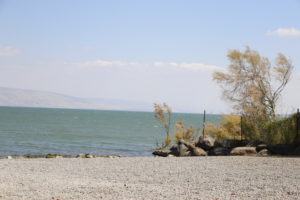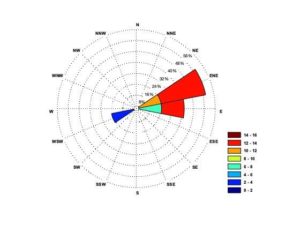We continue with the series of articles about the Sea of Galilee. In the first article, we analyzed “The Sea of Galilee and its Climate” and in the second “The Winds at the Sea of Galilee”. The strongest winds often bring storms, and as the Gospel points out, on at least two occasions, the Lord showed his mastery over nature by calming the fierce winds of the lake.
As narrated by Saint Luke (8:22-25): “One day he got into a boat with his disciples and said to them, ‘Let us cross to the other side of the lake.’ So they set sail, and while they were sailing, he fell asleep. A squall blew over the lake, and they were taking in water and were in danger. They came and woke him saying, ‘Master, master, we are perishing!’ He awakened, rebuked the wind and the waves, and they subsided and there was a calm. Then he asked them, ‘Where is your faith?’ But they were filled with awe and amazed and said to one another, ‘Who then is this, who commands even the winds and the sea, and they obey him?’”
Saint John also relates a similar account (6:16-21): “When it was evening, his disciples went down to the sea, embarked in a boat, and went across the sea to Capernaum. It had already grown dark, and Jesus had not yet come to them. The sea was stirred up because a strong wind was blowing. When they had rowed about three or four miles, they saw Jesus walking on the sea and coming near the boat, and they began to be afraid. But he said to them, ‘It is I. Do not be afraid.’ They wanted to take him into the boat, but the boat immediately arrived at the shore to which they were heading.” This episode is also mentioned by Saint Matthew (14:22-33) and Saint Mark (6:45-52), with an important addition that Jesus not only walked on water but “he got into the boat with them, and the wind died down” (Mk 6:51).

Sea of Galilee
In this article, we will describe the storms that develop at the Sea of Galilee in present times, as they are likely of the same nature as those that occurred during the time of Jesus.
The storms at the Sea of Galilee come from three directions: East, South, and West.
The strongest storms originate from the East. The storm described in Luke 8:22-25, along with its parallels in Matthew and Mark, appears to be a detailed account of a storm generated by winds blowing from the eastern shore of the lake. This wind is known as the “Sharkia” (Shark meaning East in Arabic). These storms usually start in the early afternoon and continue to cause apprehension among local fishermen to this day (Mendel Num, 1985). A notable example of these storms occurred on March 11 and 12, 1992 (Figure 1), with winds reaching 50 km/h.
Of lesser intensity are the storms from the South. These winds exceed 30 km/h and, as we mentioned in our previous article (The Winds at the Sea of Galilee, Figure 1), being desert winds, they are very warm and carry a significant amount of suspended particles.
Lastly, storms from the West are also very dangerous as they arrive suddenly. “In the narrow, long, and winding wadis of this semi-mountainous area on the western side of the Sea of Galilee, gusts of wind form rapidly, forcefully entering between steep cliffs and descending with increasing power onto the lake, situated 200 meters below sea level. In a matter of minutes, these gusts of wind transform the smooth surface of the water into a seething and roaring cauldron. The storm rushes with mighty force onto the modest Sea of Galilee; the hurricane collides with the mountains that close off the eastern shore and merges with the winds that continue blowing, such that a hurricane can form in an instant” (Wilkem, K.E. 1956).
Jesus, the Creator of heaven and earth, demonstrated his mastery over the most intense natural phenomena at the Sea of Galilee, calming storms to foster the growth of his disciples’ faith as well as ours.
By father Alfonso Sánchez Lamadrid

Figure 1. Compass rose for the Sea of Galilee during Eastern storm days (Capernaum Station, March 11 y 12, 1992, http://ims.data.gov.il)
